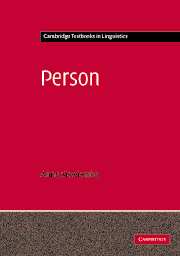Book contents
- Frontmatter
- Contents
- List of figures
- List of tables
- Preface
- List of abbreviations
- 1 Introduction
- 2 The typology of person forms
- 3 The structure of person paradigms
- 4 Person agreement
- 5 The function of person forms
- 6 Person forms and social deixis
- 7 Person forms in a diachronic perspective
- Appendix 1 List of languages in the sample by macro-area
- Appendix 2 Genetic classification of languages cited in the text
- References
- Author index
- Language index
- Subject index
7 - Person forms in a diachronic perspective
Published online by Cambridge University Press: 05 June 2012
- Frontmatter
- Contents
- List of figures
- List of tables
- Preface
- List of abbreviations
- 1 Introduction
- 2 The typology of person forms
- 3 The structure of person paradigms
- 4 Person agreement
- 5 The function of person forms
- 6 Person forms and social deixis
- 7 Person forms in a diachronic perspective
- Appendix 1 List of languages in the sample by macro-area
- Appendix 2 Genetic classification of languages cited in the text
- References
- Author index
- Language index
- Subject index
Summary
Although person markers are often seen as belonging to the more stable parts of a language, like all other grammatical markers they too are subject to change. In this chapter we will consider the diachronic changes that person markers undergo and the factors underlying these changes. We will first discuss the origins of person markers, then some of the ways in which they may change and finally how they are lost. Central to our considerations of the historical development in person markers will be the notion of grammaticalization, that is the change from lexical item to grammatical marker or from less grammaticalized to more grammaticalized marker. Grammaticalization is a complex phenomenon involving a number of changes – phonological, morpho-syntactic and semantico-pragmatic. (Lehmann 1982:234–41; 1995; Heine & Reh 1984:16–46 and Croft 2000:157–65). The phonological changes involve reduction or loss of phonological material resulting in shorter forms and ultimately in the disappearance of forms altogether. The morpho-syntactic changes are reflected in the rigidification of the syntactic position of a form and, subsequently, loss of independent word status, cliticization and affixation, typically accompanied by increasing obligatoriness of the relevant form. And the semantico-pragmatic changes relate to loss of specific semantic content and acquisition of more general, often more abstract, meanings. These changes are conceived of not as discrete, but rather as gradual transitions which together “form a natural pathway along which forms evolve” (Hopper & Traugott 1993:6). This is typically referred to as a grammaticalization cline.
- Type
- Chapter
- Information
- Person , pp. 246 - 281Publisher: Cambridge University PressPrint publication year: 2004



